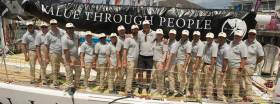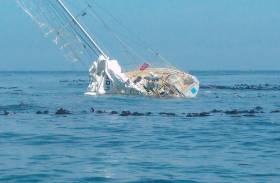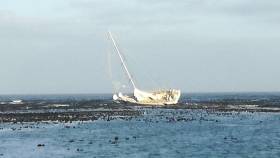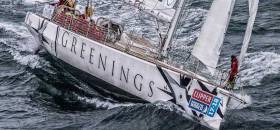Displaying items by tag: Greenings
Clipper Race: Red Tape Blocks Greenings Salvage Efforts
#ClipperRace - The Greenings team’s grounded Clipper Race yacht has still not been salvaged due to red tape around its sensitive location, as South Africa’s Times Live reports.
The vessel ran aground off the Cape Peninsula on Tuesday 31 October just hours after the fleet set out on the third leg of the round-the-world yacht race.
Two weeks on and the boat is beached near Olifantsbospunt, a protected area within Table Mountain National Park.
That means any efforts to remove the vessel are subject to environmental legislation over potential damage by the heavy equipment that would be required.
Wildfires on the mainland nearby have also delayed action on the yacht, which has had its fuel removed along with loose fittings to avoid pollution.
However, the €6 million boat remains vulnerable to looters, says local salvage diver Gary Mills, who claims government officials should have acted sooner while it was wedged on a nearby reef.
Members of the Greenings crew will be reallocated across the rest of the fleet from the start of the next leg from Fremantle to Sydney next month.
In other Clipper Race news, the Unicef team has been awarded 2 hours and 33 minutes redress by the race committee after their rescue stand-by delay at the start of Race 3.
Final race positions for Race 3: the Dell Latitude Rugged Race will be announced after redress has been applied to the elapsed time.
As of Wednesday morning (15 November) the bulk of the fleet has now passed the halfway mark en route to Fremantle in western Australia.
The sailors on Sanya Serenity Coast have extended their lead to almost 160 nautical miles over nearest rivals PSP Logistics, as fast downwind conditions have been replaced by shifting winds and lighter airs for many teams.
Clipper Race: Greenings Partially Under Water After Grounding, Team’s Race Future In Doubt
#ClipperRace - The Clipper Race office has confirmed that the Greenings yacht that ran aground off South Africa’s Cape Peninsula on Tuesday night (31 October) is partially underwater and will take no further part in the 2017-18 race.
As previously reported on Afloat.ie, the boat’s interim skipper and crew were evacuated after it ran aground on the western side of the peninsula just hours after starting the third leg from Cape Town to Perth.
Clipper Race officials also confirm that discussions have taken place between interim skipper Andy Woodruff, previously injured skipper David Hartshorn and the crew regarding their future participation in this edition of the race.
A full investigation of the incident is underway, according to the race office. Meanwhile, underwriters have appointed a surveyor to attend the boat today (Thursday 2 November). Following the surveyor’s report, a decision will be made as to whether or not the boat will be salvaged.
In other Clipper Race news, atypically light winds becalmed the majority of the fleet in wind holes on day two, with frustration leading to divided routing that’s split up what had been a tight pack in the first 24 hours out of Cape Town.
First-placed Sanya Serenity Coast is some 30 nautical miles ahead of PSP Logistics, and both have been joined on the rhumb line by third-placed Unicef, making up significant ground after their Greenings rescue stand-by delay late on Tuesday.
South of the line, Dare To Lead is in a battle for fourth with Visit Seattle with barely 1.5nm between them, while just 14nm separates sixth-placed Garmin from the Irish-skippered HotelPlanner.com in 10th — with Liverpool 2018, Qingdao and GREAT Britain in train between them, and Nasdaq catching up another 11nm behind.
The spell of light winds is now passing, and breezes building over the coming days should give teams their first sense of true Southern Ocean conditions.
Clipper Race weather guru Simon Rowell says the next front is due to catch up with the fleet overnight — and with it, the fleet is likely to see wind speeds gust up to 50 knots.
Clipper Race: Greenings Crew Evacuated After Running Aground
#ClipperRace - Greenings’ stand-in skipper Andy Woodruf and crew were reportedly doing well after some rest in Cape Town hours after they ran aground on the western side of the Cape Peninsula last night (Tuesday 31 October).
No injuries were reported on board when the boat hit a rocky shoal around 11.40pm local time (9.40pm Irish time) last night, not long after the fleet departed Cape Town on the third leg of the Clipper Race.
However, as a precaution, rescue boats were called to evacuate the crew to shore at Hout Bay.
Unicef, as the closest race vessel to the incident, was initially asked to stand by to assist but was later released to continue racing.
It’s the second major incident to hit the Greenings team after skipper David Hartsthorn suffered a serious hand injury in late August during Race 1 from Liverpool to Uruguay.
The crash will also bring back memories of Team Vestas Wind’s disastrous grounding in the Indian Ocean in the 2014-15 Volvo Ocean Race. That team’s new incarnation as Vestas 11th Hour Racing is faring much better in the latest edition, last week winning the first leg from Alicante to Lisbon.
Meanwhile, the rest of the Clipper fleet continues their race across the southern Indian Ocean from Cape Town to Perth in Australia.
First across the start line yesterday was Dare To Lead, which had to use all of skipper Dale Smyth’s local knowledge of the waters around Cape Town to move into second place as Sanya Serenity Coast was first to round the first mark in Table Bay.
Dare To Lead has since slipped into third behind PSP Logistics, which had been nipping at their heels all of this morning (Wednesday 1 November).
Sanya Serenity Coast is currently leading the way in The Dell Latitude Rugged Race 3, with a 35 nautical mile advantage on their closest rivals.
Visit Seattle, Garmin, GREAT Britain, HotelPlanner.com, Joker Card players Qingdao and Liverpool 2018 make up the rest of the chasing pack, in order, with only four nautical miles separating the front from the back.
Behind them NASDAQ is some 30nm adrift, while Unicef’s crew have some catching up to do after last night’s rescue detour as they currently lie some 96nm behind the leaders.
#ClipperRace - A Clipper Race yacht is diverting to Portugal after the team’s skipper suffered a serious injury to his left hand that required emergency medical attention.
Greetings skipper David Hartshorn got his left thumb caught in a spinnaker sheet while leading a drop of their code 3 heavyweight kite in breezy conditions on Saturday night (26 August), with wind blowing between 18 and 22 knots some 450 nautical miles off the Portuguese coast.
Hartshorn received treatment from team medic Miles Berry, a surgeon doing Legs 1 and 4, who also liaised with the race’s remote medical support physicians PRAXES ahead of the skipper’s helicopter medevac yesterday afternoon (Sunday 27 August).
“An agreed medevac procedure was put into place where David was lifted from the water rather than from on deck and the manoeuvre went really well,” said Clipper Race director Mark Light.
“The Greenings crew have been incredible and have remained composed throughout. They are now motoring directly to Porto under the command of Clipper Race coxswain and round-the-world crew member Jeremy Hilton.”
Deputy race director Daniel Smith is in constant communication with the crew and will receive regular updates.
Tomorrow morning (Tuesday 29 August), Greenings is expected to reach Porto, where the race crew will be met by Clipper Race officials who will advise on the next steps.
Meanwhile, the rest of the Clipper Race fleet has split into two clusters as they pass Portugal en route to South America.
On the westerly course, GREAT Britain, Liverpool 2018 and HotelPlanner.com took the gamble of adding extra miles to their route, but making up for it with more favourable wind conditions.
They’re also gaining significant time on the leaders further east, who have suffered from a wind hole over the weekend.
Indeed, the western option has paid off exceptionally well for HotelPlanner.com, skippered by Derry-Londonderry man Conall Morrison, which leapt to fifth place in the latest standings (as of 8am on Monday 28 August) and is holding sixth overall.
The weather for the week ahead looks more promising for both groups as they converge for the swing past the Azores.
































































